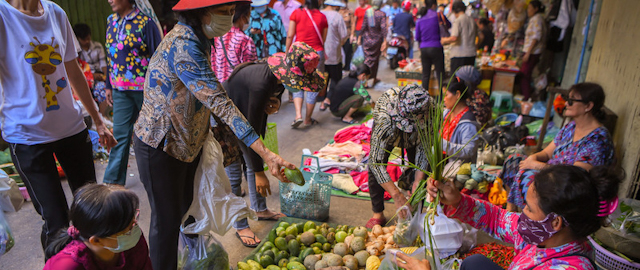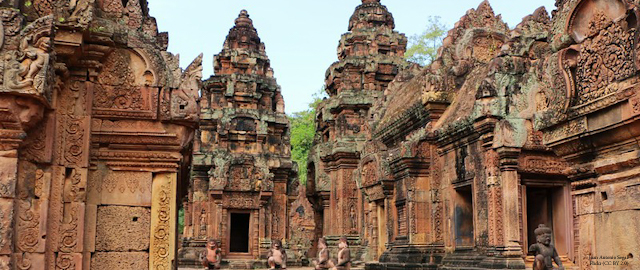





Cambodia's economic growth has been among the world’s fastest during the past quarter century, driven by garment manufacturing, tourism, rice production, and construction. In 2015, the nation achieved lower middle-income status, and has now set its sights on attaining upper-middle income status by 2030. Cambodia has made significant progress in reducing poverty and achieving many other Millennium Development Goals. The country is also very active in GMS cooperation. National development priorities include ensuring stable, sustainable, and equitable economic growth; increasing employment opportunities; improving governance; and reducing poverty further. Although many challenges remain, the country’s development trajectory holds much promise for the future.
Quick Facts
| Population | 15.77 million (2020) |
| Average Annual Population Growth Rate | 0.9% (2015-2020) |
| GDP at PPP (current international dollars) | 73.9 billion (2020) |
| GDP per capita at PPP (current international dollars) | 4,571 (2020) |
Agriculture
The high-performing agriculture sector of Cambodia has helped lift millions of people out of poverty during the past 2 decades. Higher yields, diversification, and increased farm wages have helped greatly. Although rice continues to be the most important crop, greater emphasis on vegetables, cassava, and maize are proving to be profitable. The country has benefited from agricultural investments and farming knowledge provided by its GMS partners. As agriculture remains central to Cambodia’s development strategy, the priorities include building farmers’ skills, increasing irrigation, and investing more in aquaculture and livestock. The country is also aiming to become a bigger global exporter of rice.
Energy
Cambodia has significantly increased its electricity generation in recent years by building new hydropower and coal-fired plants. However, the country still relies heavily on electricity imports from the Lao PDR, Thailand, and Viet Nam. The proportion of the population without electricity has rapidly decreased this past decade, but still remains high. Government targets include ensuring that all households have access to some form of electricity by 2020, and to grid-quality electricity by 2030. The country is also looking to increase the proportion of hydropower in the domestic energy production mix.
Environment
Cambodia is a biodiversity hot spot, rich in species and ecosystem diversity. Tonle Sap is the largest freshwater lake in Southeast Asia, supporting incredibly productive and diverse fisheries. The country’s environment includes a high proportion of natural forest, including the rain forest of the Cardamom Mountains—one of the region’s most species-rich habitats. In recent years, Cambodia has increased its efforts to prevent forest and biodiversity loss by banning economic land concessions and adding 1.4 million hectares of “biodiversity corridors” to its already extensive protected land areas. The country is also close to finalizing a comprehensive national strategy for guiding environmental sustainability efforts until 2023.
Human Resource Development and Health
Human resource development is essential for achieving Cambodia’s goal of attaining upper-middle income status by 2030. Primary education is now nearly universal, and efforts are under way to improve vocational training and higher education as a means of accelerating industrialization. Cambodia has also strengthened its health system in recent years, resulting in significant improvements in the health of women and children. The country is looking to further expand its health coverage, and is working with its GMS partners to eradicate malaria and to more effectively manage emerging diseases.
Information and Communication Technology
ICT has played an increasing important role in the impressive progress of Cambodia’s development over the past decade. Today, the vast majority of people in the country use mobile phones; and internet access continues to grow rapidly, with a quarter of the population now “online,” up from only 3% in 2011. A government priority is to continue enhancing the ICT sector, and efforts are under way to improve the country’s telecommunications infrastructure, including the extension of coverage to remote communities. Other goals include scaling up ICT use in education and stimulating more private sector investment.
Tourism
Millions of tourists visit Cambodia each year to experience the country’s rich cultural and natural heritage. Angkor Wat and Phnom Penh continue to be the main tourist destinations, while the coastal areas and the unique Tonle Sap Lake are growing in popularity. In 2016, international tourist arrivals reached 5 million for the first time, twice as many as in 2010. Cambodia is working closely with other GMS countries to promote sustainable tourism as a means of achieving inclusive economic growth and poverty reduction.
Transport
Cambodia has made important strides toward improving its transport infrastructure in recent decades. New and better roads, seaports, and airports are helping to drive trade and socioeconomic development. The country’s main national roads have been significantly improved, and road linkages with GMS neighbors greatly enhanced. But more remains to be done. With support from its GMS partners, Cambodia needs to reinvigorate its railways to create a more efficient transport system, and to build stronger linkages with neighbors such as Thailand and Viet Nam. Other priorities include upgrading rural roads and furthering subregional connectivity by strengthening the road networks along the GMS Southern Economic Corridor.
Transport and Trade Facilitation
Cambodia’s growing trade with its GMS partners—especially the PRC, Thailand, and Viet Nam—has helped the country achieve impressive economic growth in recent years. Two-thirds of Cambodia’s imports are from GMS countries (including petroleum and fabrics), and a large portion of Cambodia’s exports go to GMS countries (including agricultural products, garments, and timber). Working with its GMS neighbors, Cambodia is upgrading bilateral agreements to enhance cross-border transport and trade, including agreements to increase the exchange of traffic rights. In addition, the country now has automated customs-clearance systems, and is further developing paperless trade.
Urban Development
Although nearly 80% of Cambodians live in rural areas—the highest proportion in the GMS—the country’s urban centers are growing fast. Phnom Penh’s population has tripled since the turn of the century, and many towns in the Tonle Sap lowlands are also burgeoning. Tourism and trade are boosting growth in the port city of Sihanoukville, Siem Reap, and other towns. Cambodia is now looking to improve the streets, waste management facilities, and flood control systems in its urban centers.
GMS Program Officials and Contacts in Cambodia
- ROS Seilava (Mr)
National Coordinator Secretary of State, Ministry of Economy and Finance - SUON Sophal (Mr)
Director Department of Public Relations and Promotion of Private Investment Council for the Development of Cambodia
Greater Mekong Subregion: 25 Years of Partnership
